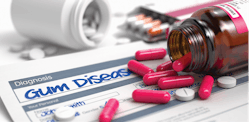Systemic antibiotics to treat periodontal disease: Are we causing more harm than good?
When conventional means of nonsurgical periodontal disease treatment do not yield desired results, systemic antibiotics are often prescribed to eliminate pathogenic bacteria. The combination of systemic antibiotics with scaling and root planing (SRP) is believed to provide greater support to the immune system in the reduction of subgingival pathogens.1 However, in considering the use of antibiotics for periodontal disease, it is important to understand that dental professionals may be contributing to a larger problem: antibiotic resistance.
Antibiotics have played an important role in dentistry and medicine in general. Diseases that were once thought incurable are now treated with antibiotics. However, the wide use of antibiotics for medical treatment and in animals raised for food has increased antibiotic resistance to a critical level. The Centers for Disease Control and Prevention reports that antibiotic resistance adds more than $20 billion each year to direct health-care costs in the United States.2
Antibiotics are thought to be the leading factor in antibiotic resistance due to their mechanism of action. Antibiotics destroy harmful bacteria, but they can also eliminate nonharmful bacteria, including those protecting the body. When this occurs, bacteria that are resistant to antibiotics thrive and multiply rapidly. As they proliferate, resistant bacteria pass on their traits, which results in even further resistance.
Improperly prescribed antibiotics
Antibiotics should be prescribed with great caution to reduce the risk of resistance. However, nearly half of all antibiotics administered today are not needed or are improperly prescribed.2
One study reports that patients with chronic periodontitis who are treated with broad spectrum antibiotics showed “significant clinical improvement” when the antibiotics were prescribed in conjunction with SRP.3 Despite this and related findings, it is important to consider that the benefits of any treatment should outweigh the overall risks, and this includes treatment with antibiotics. To prevent adverse outcomes for our patients, it is critical to consider the overall effects of antibiotics and practice evidence-based dentistry to treat periodontal disease.
Identify what we’re treating
Microbial identification through plaque analysis is important to complete prior to prescribing antibiotics to treat periodontal disease. The results of microbial analysis allow the provider to determine what kind of bacteria are in each periodontal pocket. Clinicians may elect to use a pooled subgingival sample, which provides a range of the periodontal pathogens present. This sampling can take place initially, during root planing, or during the reevaluation stage.1,3
The use of adjunctive antibiotics is usually based on a follow-up visit, and therefore results are short-term. Moreover, studies are analyzing the full effects of improved home care, SRP, rinses, and antibiotics. In two systematic reviews, Sgolastra et al. found that the beneficial use of systemic antibiotics was 0.5 mm.4 Furthermore, researchers noted that amoxicillin and metronidazole do not have specific target bacteria, and only a small portion of these antibiotics reach their targets.4 This results in the antibiotics being absorbed by other organs and contributing to resistance.
In addition to understanding the bacterial sample of the patient, the selection of antibiotic should be based on the patient’s health history, medical history, and drug allergies. The age of the patient should be considered. For example, tetracycline is contraindicated for those with developing teeth and bone.3 The renal function of the patient must be looked at to ensure that the antibiotic does not compromise the function of any organs. The immune system should also be considered to ensure that antibiotics do not further impair the patient.3 Antibiotics can also compromise the effectiveness of medications, such as oral contraceptives. Therefore, it is important to consider this and inform the patient of side effects when prescribing.
Why antibiotics?
In cases where a patient’s diligent home care and SRP are not preventing the progression of periodontal breakdown, characteristics of pathogens are often a factor.1 Lesions are often populated with a variety of pathogens rather than a single species.1 Studies on periodontal pathogens frequently focus on Gram-negative anaerobic rods; however, periodontal pathogens vary considerably in sensitivity to several antibiotics, making a straightforward approach to using antibiotics difficult.1
Studies suggest that systemic antibiotic therapy can be beneficial to patients who display attachment loss after conventional therapy. Patients with other conditions can benefit, too, including those with aggressive forms of periodontal disease, predisposing medical conditions, refractory periodontitis, acute necrotizing periodontitis, or periodontal abscesses.4
When utilizing antibiotic therapy, the need for complete mechanical removal of biofilm and calcified deposits should not be underestimated. Studies suggest that vulnerability of bacteria to antibiotics is essential to achieving healthier tissue and prevention of the progression of disease.5 Moreover, to prevent the progression of the disease, we need to empower patients on the proper home-care strategies to ensure plaque removal is effectively carried out multiple times daily.
Considerations for dosing
Lior Shapira, chairman of the Department of Periodontology at Hebrew University-Haddash, states, “Broad-spectrum antibiotics should be a weapon of last resort in extreme cases only.”6
Time-dependent antibiotics allow for a longer exposure to the antimicrobial agent.3 The prescriber of the antibiotic should take into consideration whether a loading dose is needed, as some forms of antibiotics take six to 12 hours to achieve the desired therapeutic effect.3 The use of frequent dosing of antibiotics is important to maintain constant blood levels. Encouraging the patient to take the doses according to the prescribed time line is important.
Studies on antibiotics
There are limited studies on the efficiencies of antibiotics to treat periodontal disease. In February of 2017, Cochrane published an article by Khattri et al. that demonstrated conflicting research from clinical studies on periodontal disease and protocols. The study found that “Azithromycin when compared to placebo exhibited no additional benefit along with nonsurgical periodontal therapy in periodontitis patients, which contradicts [the study by Oteo]. Similarly, choice of single antibiotics versus a combination of antibiotics is debatable for the management of periodontitis.”5
Studies conducted by Feres in 2012 found that both metronidazole and the combination of amoxicillin were effective in patients with chronic periodontitis.7 This echoed a study from Silvia in 2011, which demonstrated the “combination of metronidazole and amoxicillin were more effective than metronidazole alone.”8
Each study has a common limitation in that the improvement of periodontal depths is multifactorial. Patients yield different results based on factors such as medical conditions, medications, diet, smoking, use of probiotics, daily mechanical disruption of biofilm, and the pH of the mouth. Because periodontal disease is multifactorial, it is challenging to determine how effective systemic antibiotics are.
Resistance
Bacterial resistance has resulted in a global public health problem, resulting in an estimated death toll of 10 million worldwide by 2050.8
Antibiotics can reduce “good” bacteria along with bacteria that are causing illnesses. The flora that line the intestinal tract are diminished by antibiotics, reducing one of the body’s natural defenses from infection. This provides an opportunity for drug-resistant bacteria to grow and multiply without response from the immune system.
As Feres et al. note, “[Antibiotics] expose an individual to potential risks like the development of microbial resistance, the emergence of opportunistic fungal infections, allergic reactions, and other drug‐dependent systemic side effects.”7 This should be considered when discussing treatment recommendations with patients.
Due to the complex biological structure of plaque and the progressing of antimicrobial resistance, it has become increasingly difficult to predict the efficacy of antibiotics. Moreover, the rapid evolution of sublingual bacteria presents significant challenges in combating proliferation. As Sumanth et al. note, “Subgingival plaque is polymicrobial in nature, hence the administration of a specific antimicrobial based on antibiotic susceptibility is a challenge to the clinicians. Antimicrobial resistance (AMR) among anaerobes has consistently increased in the past three decades and the susceptibility of bacteria to antimicrobial agents has become less predictable.”8
Studies conducted found that 24.5 million courses of antibiotics were prescribed by dentists in 2013 alone.9 This is a rate of 77.5 prescriptions per 1,000 people, meaning dentists were responsible for prescribing 10% of the antibiotics administered in the United States.9
Guidelines for antibiotic recommendations require an evolution of prescription protocols with clear and concise parameters to avoid progression of resistance.10 To prevent further antibiotic resistance as dental professionals, prescribers should recommend antibiotic treatment as a last resort.10
Antibiotic stewardship
In 2013, the Centers for Disease Control and Prevention created an antibiotic stewardship program in an attempt to improve the treatment of infections and reduce the number of cases treated with antibiotics. The program was designed to educate doctors and certified prescribers to help improve quality of patient care and diminish antibiotic resistance.9,11 This effort has increased infection cure rates, reduced treatment failures, and increased frequency of correct prescribing for therapy and prophylaxis.12 Systems in hospitals have been developed to achieve antibiotic-resistance goals. These systems have clear and concise protocols for managing antibiotics.
Summary
The elimination of periodontal pathogens should not come solely from the means of antibiotics, and it is important to remember that not every periodontally involved patient requires systemic antibiotics.
Practicing evidence-based dentistry involves a complete evaluation of the patient’s case (medical history, home care, classification of periodontal state, etc.); an understanding of the patient needs; a familiarity with the current literature; and treatment that is within the provider’s expertise. All this can be done when treating periodontal disease.References
1. van Winkelhoff AJ, Rams TE, Slots J. Systemic antibiotic therapy in periodontics. Periodontology 2000. 1996;10(1):45-48.
2. Appold K. Antibiotic resistance: Impact on cost, outcomes. Managed Healthcare Executive website. Published September 1, 2015.
3. Newman MG, Takei H, Klokkevold PR, Carranza FA. Newman and Carranza’s Clinical Periodontology. 13th ed. Philadelphia, PA: Elsevier; 2015.
4. Sgolastra F, Petrucci A, Gatto R, Monaco A. Effectiveness of systemic amoxicillin/metronidazole as an adjunctive therapy to full-mouth scaling and root planing in the treatment of aggressive periodontitis: a systematic review and meta-analysis. J Perio. 2012;83(6):731-743.
5. Kapoor A, Malhotra R, Grover V, Grover D. Systemic antibiotic therapy in periodontics. Dent Res J. 2012;9(5):505-515.
6. Debate: Is it time for a rethink on the use of antibiotics to treat periodontitis? European Federation of Periodontology website. Published September 5, 2016.
7. Feres M, Soares G, Mendes J, et al. Metronidazole alone or with amoxicillin as adjuncts to non‐surgical treatment of chronic periodontitis: a 1‐year double‐blinded, placebo‐controlled, randomized clinical trial. J Clin Perio. 2012;39(12):1149‐1158.
8. Sumanth KN, Prashanti E, Bhat KG, Kusum C, Johnson TM, Lodi G. Adjunctive systemic antimicrobials for the non-surgical treatment of chronic and aggressive periodontitis. Cochrane website. https://www.cochrane.org/CD012568/ORAL_adjunctive-systemic-antimicrobials-non-surgical-treatment-chronic-and-aggressive-periodontitis. Published February 23, 2017.
9. Review on Antimicrobial Resistance. Tackling drug-resistant infections globally: Final report and recommendations. Review on Antimicrobial Resistance website. https://amr-review.org/sites/default/files/160518_Final%20paper_with%20cover.pdf. Published May 2016.
10. Keestra JA, Grosjean I, Coucke W, Quirynen M, Teughels W. Non‐surgical periodontal therapy with systemic antibiotics in patients with untreated chronic periodontitis: a systematic review and meta‐analysis. J Perio Res. 2015;50(3):294‐314.
11. Glick M. Antibiotics: The good, bad, and the ugly. J Am Dent. 2016;147(10):771-773.
About the Author

Amber Auger, MPH, RDH
Amber is a dental hygiene clinician, international speaker, and hygiene director who specializes in nonsurgical periodontal therapy, heart-centered education, and efficiency. Through her signature program, Thrive in the OP and Thrive Chairside Summit, she equips hygienists with evidence-based systems to elevate patient outcomes, confidence, and production. Amber blends clinical expertise with practical strategies to help dental teams implement sustainable, science-driven protocols. She can be reached at amberauger.com.


